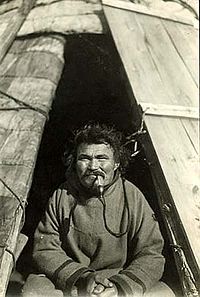Selkup people
 Flag | |
 Selkup man from Obdorsk, Ob river | |
| Regions with significant populations | |
|---|---|
| 3,649[1] | |
| Languages | |
| Selkup language | |
| Related ethnic groups | |
| Nganasans, Nenets, Enets | |
The Selkup (Russian: селькупы), until the 1930s called Ostyak-Samoyeds (остяко-самоеды), are a Samoyedic ethnic group native to Northern Siberia. They live in the northern parts of Tomsk Oblast, Krasnoyarsk Krai, Yamalo-Nenets Autonomous Okrug, and Nenets Autonomous Okrug.
History[]
Selkups speak the Selkup language, which belongs to the Samoyedic languages of the Uralic language family.
The Selkups originated in the middle basin of the Ob River, from interactions between the aboriginal Yeniseian population and Samoyedic peoples that came to the region from the Sayan Mountains during the early part of the first millennium CE.[2] In the 13th century, the Selkups came under the sway of the Mongols. Around 1628, the Russians conquered the area and the Selkups were subjugated. The Selkups joined an uprising against Russian rule but were gunned downed and defeated.[3]
In the 17th century, some of the Selkups relocated up north to live along the Taz River and Turukhan River. They were engaged mainly in hunting, fishing, and reindeer breeding. The arrival of Russian settlers to the area in the 18th century led to the Russians hunting down the reindeers of the Selkups which made breeding reindeer much more difficult.[3] During the same period, the Russians attempted to Russify and Christianize the Selkups.[3] However, many retained some of their ancient religious beliefs and customs.
During the Soviet period, the Selkups were forced to adopt a settled lifestyle and their traditional culture witnessed a severe decline. The Selkups have been facing cultural extinction and assimilation from Russian culture. They also suffer from racial discrimination, unemployment and alcoholism.[3]
According to the 2002 Census, there were 4,249 Selkups in Russia (4,300 in 1970).
There were 62 Selkups in Ukraine, only one of whom is a native speaker of the Selkup language (Ukrainian Census 2001).
Culture[]
The Selkups traditionally engaged in hunting, fishing, and reindeer herding as subsistence. The Selkups also utilized dugout canoes to sail on rivers.[4]
References[]
- ^ Russian Census 2010: Population by ethnicity (in Russian)
- ^ Flegontov, Pavel; Changmai, Piya; Zidkova, Anastassiya; Logacheva, Maria D.; Altınışık, N. Ezgi; Flegontova, Olga; Gelfand, Mikhail S.; Gerasimov, Evgeny S.; Khrameeva, Ekaterina E. (2016-02-11). "Genomic study of the Ket: a Paleo-Eskimo-related ethnic group with significant ancient North Eurasian ancestry". Scientific Reports. 6: 20768. arXiv:1508.03097. Bibcode:2016NatSR...620768F. doi:10.1038/srep20768. PMC 4750364. PMID 26865217.
- ^ Jump up to: a b c d "The Selkups". www.eki.ee. Red Book of the Peoples of the Russian Empire. Retrieved 2020-09-05.
- ^ Forsyth, James (1994). A History of the Peoples of Siberia: Russia's North Asian Colony 1581-1990. Cambridge University Press. p. 20. ISBN 978-0-521-47771-0.
Further reading[]
- Sobanski, Florian (March 2001). "The southern Selkups of Tomsk Province before and after 1991". Nationalities Papers. 29 (1): 171–179. doi:10.1080/00905990120036448. S2CID 177457842.
External links[]
- Article on Selkups from the Red Book of the Peoples of the Russian Empire
- A Selkup fisherman from Western Siberia
- Selkup people
- Ethnic groups in Russia
- Nomadic groups in Eurasia
- Indigenous peoples of North Asia
- Modern nomads
- Samoyedic peoples
- Nenets Autonomous Okrug
- Yamalo-Nenets Autonomous Okrug
- Indigenous small-numbered peoples of the North, Siberia and the Far East